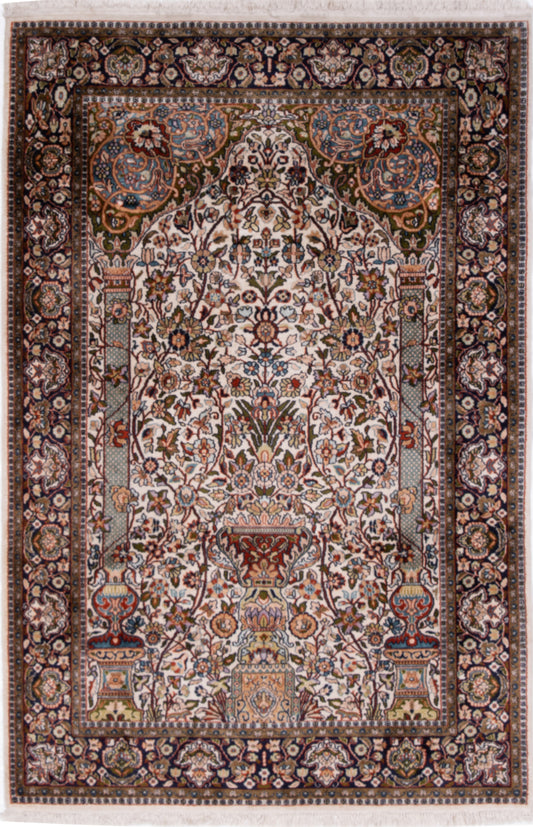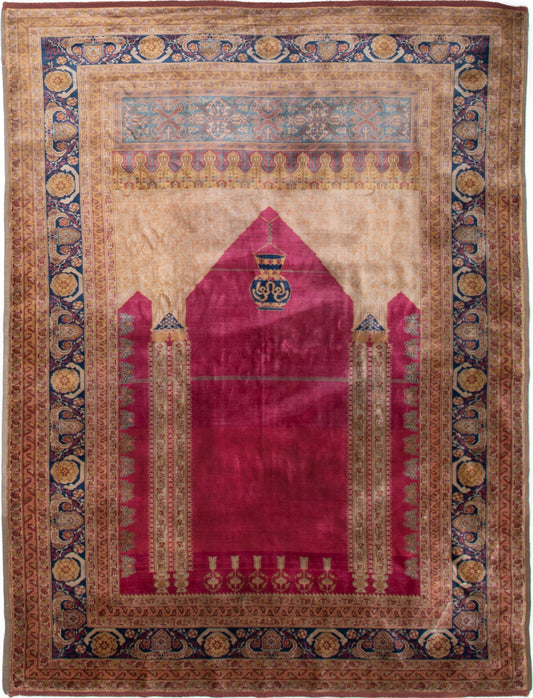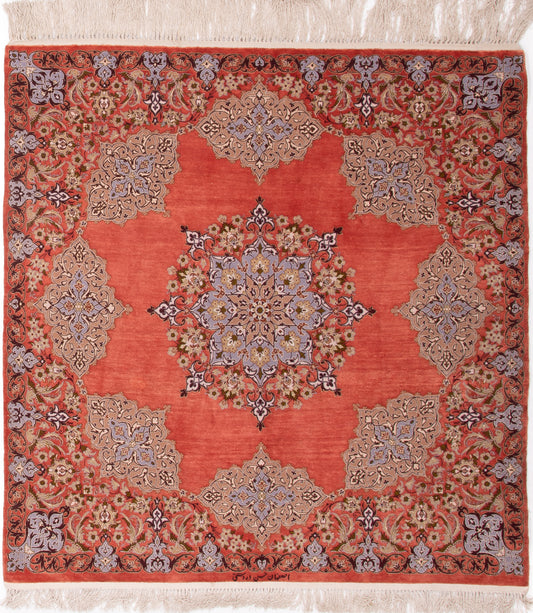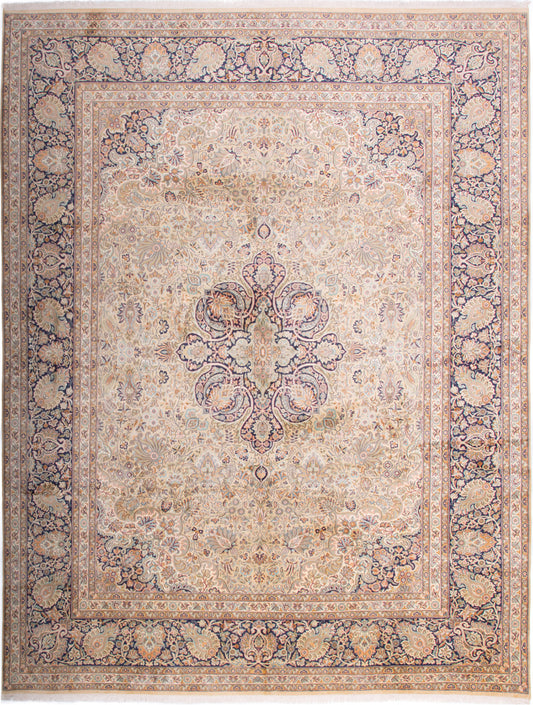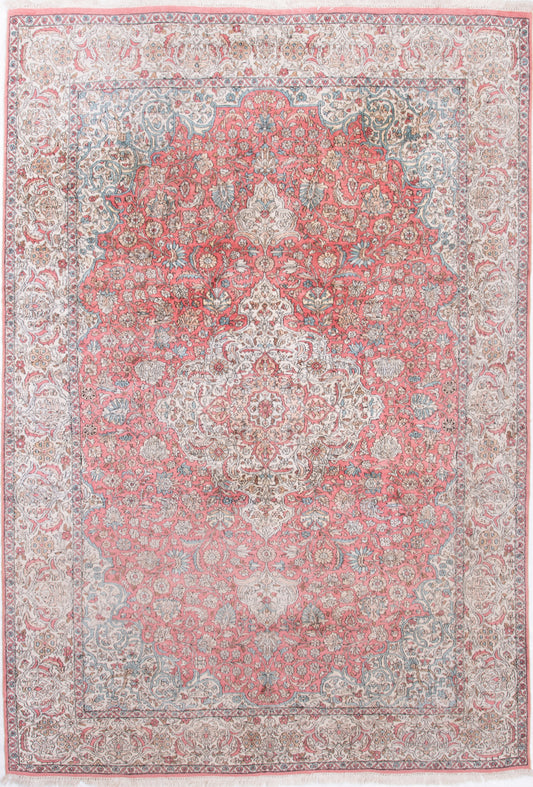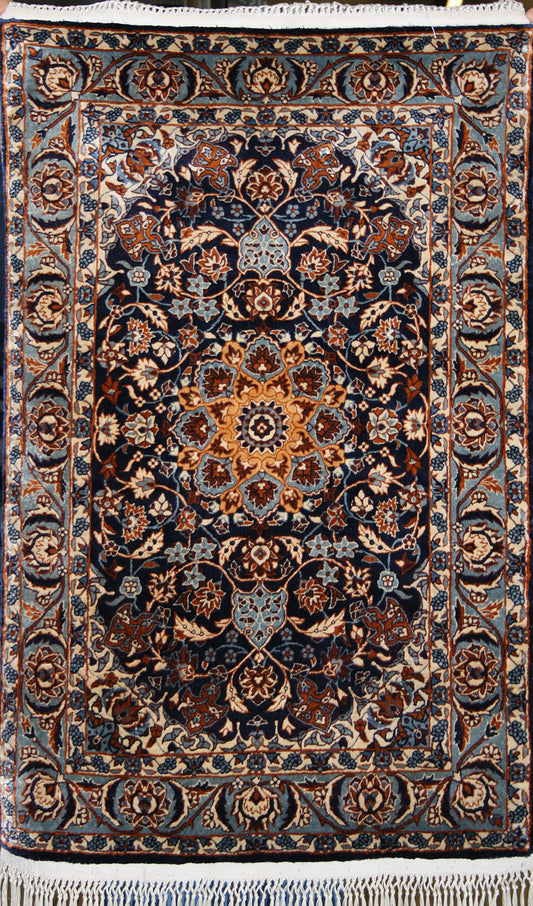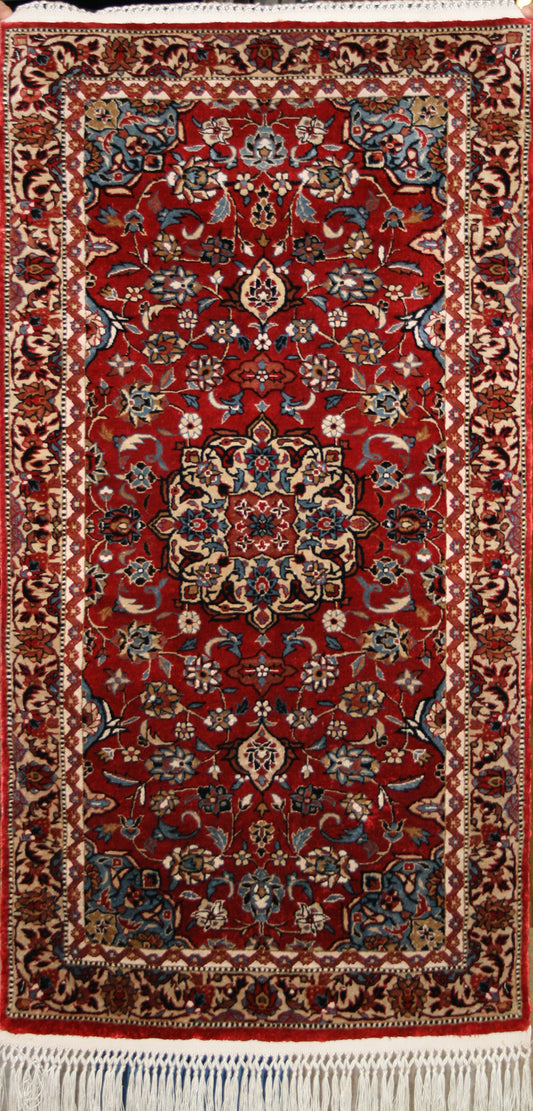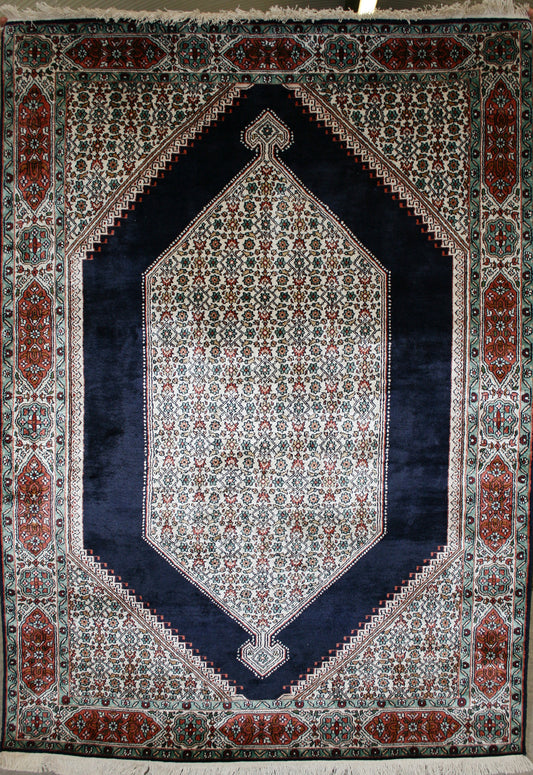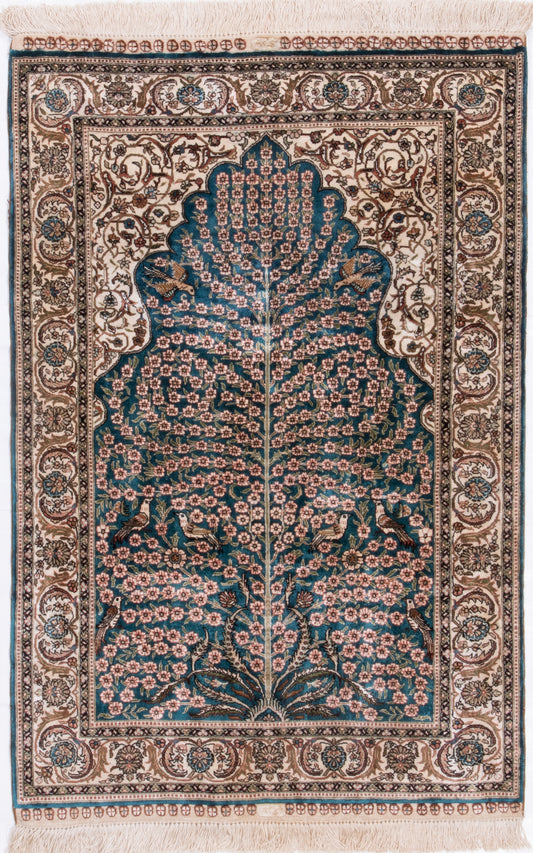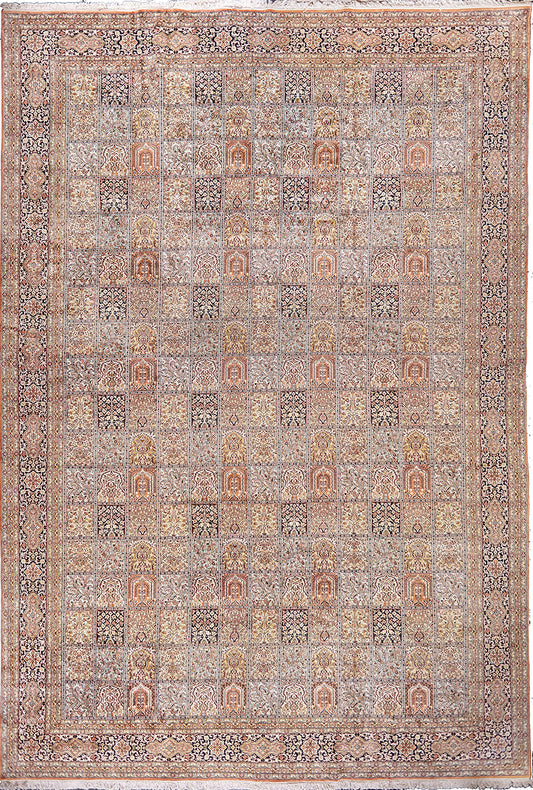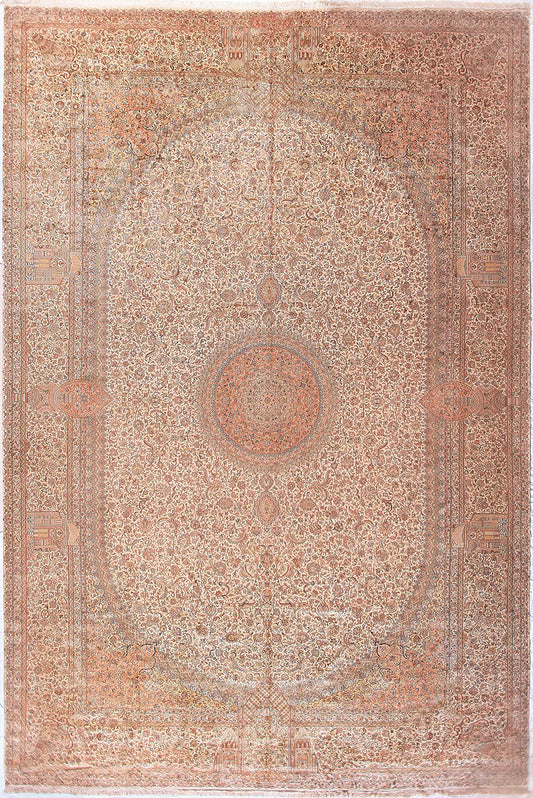Handmade Silk Rug Guide
Introduction to Handmade Silk Rugs
Handmade silk rugs are the epitome of the artisan’s craftsmanship in the world of rugs, holding the title as the most intricate, and often the most valuable, of all hand-knotted rugs. These artworks underfoot are crafted from fine, yet remarkably strong, silk fibres which allow for a higher density of knots per square inch. This results in clearer patterns, more intricate detailing, and an increased likeness to real-life scenarios, much akin to the difference between a regular TV and an HDTV.
The most valuable silk rugs are those that are 100% silk, from the warp and weft to the pile. Due to their silk foundation, these rugs can have more warp strings (visible as tassels or fringes at the ends of the rug) across the width, allowing for more knots to be tied in a given area. This, paired with the use of more expensive materials and finer knot counts, necessitates more skilled artisans.
Types of Handmade Silk Rugs
Handmade silk rugs come in a variety of styles and origins, each with its unique charm and history.
The Oriental Silk Rug
The term "Oriental" refers to rugs produced in countries of the Orient, which includes China. Chinese silk rugs are revered for their exquisite craftsmanship and high knot density. They often feature symbolic motifs and a wide array of colours.

The Persian Silk Rug
Persian silk rugs, such as the Persian Qom, are often made in smaller sizes, typically around 1.5x1m, but can be found in larger dimensions. They are known for their high quality and intricate designs, with some of the most expensive rugs ever sold at public auctions being Persian silk.
The Indian Silk Rug
Indian silk rugs, especially those from Kashmir, can be made from silk but woven on a cotton foundation. These are generally larger pieces with lower knot counts, providing an opportunity for those desiring a large silk rug without the accompanying hefty price tag.
The Chinese Silk Rug
Chinese silk rugs, particularly the Chinese dragon rug, are known for their distinctive designs and high knot densities. They offer a beautiful blend of rich history and craftsmanship.
The Turkish Silk Rug
Turkish silk rugs, such as the Hereke silk rug, are highly esteemed for their intricate designs and the skill involved in their creation. Hereke silk rugs, for example, are renowned for their high quality and are often considered as works of art.

The Kashmir Silk Rug
Kashmir silk rugs are known for their high quality and beautiful, intricate designs. Despite being made from silk, they are woven on a cotton foundation, making them a more affordable option for those desiring a large silk rug.
The Modern Silk Rug
Modern silk rugs bring a contemporary spin to the ancient art of rug making, featuring updated designs and colour palettes, while still retaining the high quality and intricate knotting techniques of their traditional counterparts.
Materials and Construction of Handmade Silk Rugs
The quality of a handmade silk rug is largely determined by the materials used and the craftsmanship involved in its creation. The most valuable rugs are those made entirely of silk, from the warp and weft to the pile. This silk foundation allows for a higher density of warp strings, hence, more knots can be tied within a given area.
Many Persian and Oriental rugs use wool, often 'kork' wool or merino, with silk details to add luxury and depth to their designs. These rugs are woven on a silk rather than cotton foundation, providing the rug with strength and flexibility while allowing for tighter, more accurate knotting than thicker strands of cotton would allow.
Some rugs, particularly those from Kashmir, are made from silk but woven on a cotton foundation. This allows for the creation of larger pieces with lower knot counts, making silk rugs more accessible to those who desire them. These rugs generally have a knot-count similar to a good wool rug, meaning it takes the same amount of time to weave. The additional cost over a fine wool rug is due to the more expensive materials used, without the extra time, labour, and expertise required to weave the piece over a normal wool carpet.


A typical Persian or Oriental rug made in wool might have between 100 and 300 knots per square inch, while a typical 100% silk rug would have between 300 and 600 KPSI. This higher knot density means that weaving the rug requires 3-4 times the amount of work, which becomes more skilled the more intricate the pattern. Consequently, this results in at least a 3-4 times increase in the price. However, the beauty and longevity of silk rugs make them well worth the investment.

Design and Symbolism in Handmade Silk Rugs
The designs of handmade silk rugs are intricate and rich with symbolism. The motifs, colours, and patterns used in these rugs often tell stories, represent beliefs, or depict the natural world. Different regions and cultures have their unique design elements and motifs, making each rug a piece of art that reflects its origin.
Persian Silk Rug Design
Persian silk rugs are renowned for their detailed designs and elaborate symbolism. The motifs used often depict scenes from Persian literature, religious stories, or elements of nature. For instance, a tree could represent life and eternity, while birds might symbolise happiness and joy. It's common to see intricate floral patterns and hunting scenes in Persian silk rug designs.
Oriental Silk Rug Design
Oriental silk rugs, particularly Chinese ones, often feature symbolic motifs like dragons, phoenixes, and flowers. Each of these symbols carries a unique meaning: dragons represent power and good luck, phoenixes symbolise renewal, and flowers like peonies stand for wealth and honour.
Turkish Silk Rug Design
Turkish silk rugs, such as Hereke rugs, are known for their intricate designs and the use of naturalistic motifs like flowers, leaves, and vines. These symbols often have complex meanings tied to Turkish culture and history.
Use of Handmade Silk Rugs in Home Décor
Handmade silk rugs are much more than just floor coverings; they are exquisite pieces of art that can transform any space. However, they are not just for the floor. Given their beauty and value, many people choose to display them on walls or in low-traffic areas to prevent wear and tear.
The intricate designs and vibrant colours of silk rugs can serve as the focal point of a room. You can match the rug's colours with the room's existing palette or use it to introduce new colours and patterns into the space. A well-chosen silk rug can tie a room together, providing a sense of cohesion and elegance.
Silk rugs are versatile and can work with various interior styles. In a traditional or classic setting, a Persian or Oriental silk rug can add a touch of luxury and sophistication. In a modern or contemporary space, a silk rug with a less conventional design or a muted colour palette can offer a chic and stylish look.
Despite their delicate appearance, quality silk rugs are quite durable. However, they require careful handling and maintenance. It's recommended to keep them away from high-traffic areas and to clean them professionally to maintain their beauty and longevity.
Caring for Your Handmade Silk Rug
While handmade silk rugs are works of art, they are not as fragile as one might think. With proper care, they can maintain their beauty for generations. Here are some essential tips for caring for your silk rug:
Cleaning Your Silk Rug
- Vacuuming: Use a vacuum without a beater bar or power head to avoid damaging the silk fibres. Vacuuming in the direction of the pile will help maintain the rug's sheen.
- Spot Cleaning: Clean spills immediately to prevent staining. Blot the spill with a clean, damp cloth. Do not rub, as this can cause the stain to spread. It's advisable to test any cleaning product on a small, inconspicuous area first to ensure it doesn't affect the rug's colours.
- Professional Cleaning: Given the value and delicacy of silk rugs, it's best to have them professionally cleaned. Professionals have the necessary knowledge and equipment to clean silk rugs without damaging them.
Rotation
Rotate your silk rug every six months to a year to ensure even wear and fading. This rotation is especially important if your rug is exposed to sunlight, which can cause colours to fade over time.
Use a Rug Pad
A rug pad provides a layer of protection between your rug and the floor, preventing slippage, adding cushioning, and helping the rug retain its shape.
Buying a Handmade Silk Rug
Buying a handmade silk rug is an investment. These rugs, especially when made entirely of silk, can be quite expensive due to the high cost of silk and the labour-intensive process of hand-knotting. However, a genuine silk rug holds its value well and can even appreciate over time. Here are some factors to consider when buying a silk rug:
Authenticity
Ensure that the rug you're buying is genuine silk. Some rugs are made from artificial silk or a mix of silk and other materials. While these can still be beautiful rugs, they do not have the same value or longevity as 100% silk rugs. Always buy from a reputable dealer, and do not hesitate to ask for proof of authenticity.
Knot Count
The knot count, or knots per square inch (KPSI), is an indicator of a rug's quality and detail. Silk rugs typically have a high knot count due to the fineness of the silk fibres. A higher knot count usually means a more intricate design and a higher price.
Condition
Examine the rug's condition carefully. Look for any signs of damage or wear, such as holes, stains, or faded colours. Also, check the rug's shape to ensure it lays flat and evenly on the floor.
With these factors in mind, a handmade silk rug is a beautiful addition to any home and a valuable investment that can be appreciated for generations to come.
In Summary
Handmade silk rugs are luxurious, intricate, and rich in cultural significance. Originating from various regions, each rug tells its unique story through its design and craftsmanship. While they require careful handling, with appropriate care, these rugs can serve as a timeless centrepiece in your décor, providing elegance and sophistication for many years. Purchasing a handmade silk rug is not just buying a floor covering but investing in a piece of art that carries history, craftsmanship, and cultural heritage.
Browse Our Current Selection of Silk Rugs
-
Semi-Antique Indian Kashmir Silk Rug
Regular price £895.00Regular priceUnit price / per -
Persian Silk Qom Rug
Regular price £3,495.00Regular priceUnit price / per -
Antique Turkish Konya Rug
Regular price £6,975.00Regular priceUnit price / per -
Persian Isfahan Silk Rug
Regular price £4,195.00Regular priceUnit price / per -
Indian Kashmir Silk Rug
Regular price £9,475.00Regular priceUnit price / per -
Semi-Antique Indian Kashmir Silk Rug
Regular price £2,995.00Regular priceUnit price / per -
Chinese 250 Line Silk Rug
Regular price £1,495.00Regular priceUnit price / per£1,795.00Sale price £1,495.00Sale -
Chinese 200 Line Silk Rug
Regular price £1,295.00Regular priceUnit price / per£1,495.00Sale price £1,295.00Sale -
Pak-Persian Sanandaj (Senneh) Silk Rug
Regular price £2,495.00Regular priceUnit price / per -
Turkish Hereke Silk Rug
Regular price £1,675.00Regular priceUnit price / per -
Indian Kashmir Silk Rug
Regular price £21,475.00Regular priceUnit price / per -
Indian Kashmir Silk Rug
Regular price £52,800.00Regular priceUnit price / per

